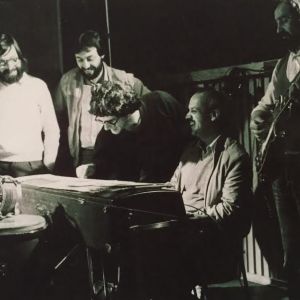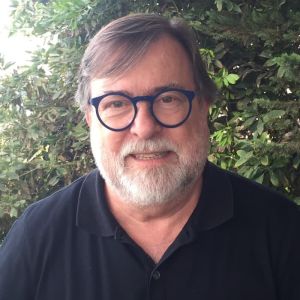Well, the first thing you need to know is that I am an authentic product of the historical circumstances of this country. I started studying Law. And I did it while living in a community of Mapu youth in a neighborhood, in the Joao Goulart neighborhood, at kilometer 18 of Gran Avenida. Anyway, sorry, it was on Santa Rosa Avenue. And there, the military coup caught us. As a result of the military coup, I was expelled, thrown out of university. I lost my job, and at that time, I was a member of the communications commission of MAPU, so I worked at a radio station, and suddenly everything was gone. With the aggravating circumstance that I got married on August 15, just a few days before the coup, and we were expecting a baby, so it was a situation of starting from scratch completely in life. First, we had to hide, then completely change our activities. With my father, who briefly went through Quiriquina, a detention center in Concepción. With a sister who went into exile for twenty years, and with a network of friends who were all in complete marginalization. So, without the Law School, I had also started studying journalism. Without the School of Journalism, newly married and in need of work, what I did was turn my hobby, which was music, into a profession. Together with another person, we created a small and marginal advertising production company that gradually grew in size, consistency, and power in terms of advertising.
I set up a music recording studio with my partners, a music recording studio. All the alternative music of the time was recorded there. A lot of it. Practically all the alternative music. I remember we went to New York in 1979 to buy that studio, the latest model. The exchange rate was very low in Chile, so we could afford it. We did it, and well, that was a production house that years later became the house from which the “No” campaign was carried out. For logical reasons and due to my profession, skills, and expertise, I was asked to create the music for the “No” campaign, including the central song, etc. So, first, I had a lot of conversations with Eugenio Tironi and with politicians, with all of this, you know, to understand this campaign that had a… because you know that there were two main paths to defeat the dictatorship: the armed path and the one that was chosen, the path of elections, the plebiscite, and everything else. So, it was very important to give consistency to that, and three or four concepts remained deeply ingrained in my mind. First, that we had to vote for a negative concept. The word “No” is a negative concept. How to make it positive? Second, that the music had to help dispel fear. At that time, there was a lot of fear, fear of going out, fear of being seen, fear of what they would say, fear of being imprisoned, fear of angering Pinochet.
Look, look, we had to overcome fear. Third, this had to be a work that had to be very inclusive. So, the first musical decision I made was: I’m not going to use panpipes, flutes, or charangos, nothing like that. Instead, I’m going to use a concept of pop music from that time, which is the most open, the most inclusive, the least confrontational, the least ideological. Understand that it was a theoretical decision, not something that just came to me. It was a theoretical decision. We’re not going to use them. Many people didn’t like that decision. Some would have preferred something more like Quilapayún, more, but I thought that’s what needed to be done at that moment. Secondly, it had to have the virtue of being sung by regular people, not by Verónica Villarroel singing opera or by the Prisioneros in their particular style. Anyone could sing it. So, I chose a song format that had some reminiscence of what happens in stadiums: “Chile, la alegría ya viene!” (Chile, joy is coming!). It’s very simple, very participatory, very collective. And then the soloists, at least the male soloist, we made sure he had a normal voice, a normal pop voice, calm, without great vocal acrobatics. And that’s how we did it.
Then I sat down at the piano, first with all those concepts, and then I sat down with the guitar. I played two, three, or four chords, and we went from there. The second thing is that I have a very good communication with the person who wrote the lyrics, the lyrics of the song. We talked a lot, and he wrote a long number of stanzas, many of which I later edited and incorporated into the music. Sergio Bravo. So, with that whole structure of things, like an architect, the last thing to do is the melody and harmony, rhythm, you know, which was also very simple, very straightforward, but it turned out very beautiful. The arrangements were done by the person who had been working with me for many years, Edgardo Riquelme, a great guitarist who still plays. Now, I come from a creative process where the people involved have a lot of participation. If a singer has difficulty hitting a note for the third time, I change the note. In other words, they had a lot of input. And here, the soloists participated, for example, Rosita Vallejos, who was the person, sorry, Rosita Escobar, who was the female singer. I had no idea. She was the daughter of the disappeared, with a beautiful voice, and I selected her from the choir. I was thinking of calling a well-known singer, but with a voice. I still didn’t know who was going to sing. So, first, I called the choir to sing “Vamos a decir que No” (Let’s say No) or “Chile, la alegría ya viene” (Chile, joy is coming). But I wasn’t sure about the soloists. The male voice, I knew Guzmán was going to be the singer, but I wasn’t clear about the female voice.
And from that choir, this girl with a beautiful voice appeared. So, we had her sing. What she did was very, very powerful. Of course, later on, you understand that if a person had a personal experience, what they contributed there was very beautiful. And that’s how the song came together. The truth is, the first time I felt that it had caught on was when I went to the city center, near Plaza de Armas, and there was a group of students. I have no idea how it all happened. It was the end of September, shortly before the plebiscite, you know, and there was a group of students singing “Chile…” So, I said, “Okay, this is working.” It was a, how should I say it, what we had envisioned worked. It was very exciting, very moving because there you feel that the song is no longer yours.
Many people participated in the song. The soloists participated, the choir called Coro bajo cuerda, which was a university choir, participated. My small choir, the one I worked with for jingles, also participated, so it was very collective, but it was very beautiful. Nobody got paid. It was a very, very collaborative work. That’s why I believe this is the most cooperative and collective work I’ve ever been involved in. I think so. There were so many people.
I remember the music video, which was the big audiovisual impact for the song “Chile la alegría ya viene.” It was done in the following way. I finished the song and I showed it to a friend of mine, Pancho Vargas, who worked with me in the visual production company. I said, “Look, I finished it,” and I showed it to him. He said, “Oh, it’s beautiful, but a bit too pop. Okay, what can we do?” Pancho told me, “Look, because we have to present it to the political group Gabriel Valdés, Ricardo Lagos, Enrique Silva, all the old political figures. And this dumbass guy, in one night, I don’t know how he did it, he took parts from movies, commercials, and put together the video that later became the No video, with various images patched together. So, we presented just the song, we presented the song with an idea, with a framework of how the video should be. And they watched it and left. Nobody questioned whether it was pop or not, everyone was delighted. And then, well, what do we do now? We can’t present this because these are not our images, they are movie images. So, this same character, Pancho, coordinated the participation of at least 20 film directors, both from advertising and cinema, like Silvio Cayói, the Bustamante brothers, and others. Each one contributed a scene. Some had the scene with the king without a crown, others with actors, someone did the horse scene. Everyone participated, and nobody was left out. It was incredible.
That’s why I’m telling you, this is a very collective work, and it turned out beautiful. It’s not just the music; it’s the music and a social state that is willing to interact. What happens is very dialectical. Nothing happens in isolation. Nothing. Not love, not hate, nor anything that happens with our senses. The violence proposed by Pinochet’s dictatorship in their campaign of terror and such, it was something that had society up to here. I wasn’t willing to speak in that tone, which was exhausted from that dark, violent, and imposing atmosphere, no matter how much Pinochet dressed himself up with a pearl and whatever else. It was something that was exhausted. And then this new thing emerges, and in the end, I didn’t create the song. The song was created by the social mood of the moment. Perhaps that same song during the time of the Popular Unity would have been ridiculous, no matter how pop it was, no, it wouldn’t fit. But now was the moment because, among other things, the political message that wanted to be conveyed was a message that was open, transversal, not exclusive but inclusive. I always remember, it didn’t make it into the lyrics, but there was a verse that spoke of sweeping inward. That means throwing the dirt inside and not sweeping it outside. Sweeping is sweeping. And so, I believe the music worked because the soup was ready. The social mood was there, the task that had been accomplished, I have no idea. Even the Church, in its collaboration with Human Rights, was there. Well, the language being used. Everyone thought that maybe the slogan was going to be a violent, aggressive slogan, but it wasn’t. “Chile, la alegría ya viene” (Chile, happiness is coming). The whole campaign was without hatred, without violence, vote no. It was all like a language, a somewhat Mahatma Gandhi-like thing, is it too much to say? But somewhat inclusive, peaceful, and optimistic. For Chile in ’88, it was very difficult. Just a year before, there had been a couple of significant murders. They were still raiding people’s homes in the shantytowns at five in the morning to search for anything. So, there was a very tense state. This was very counterintuitive. And I’ll tell you, it was a collective task involving right-wing Christian Democrats and communists. So, it was a truly collective work, involving people from the streets. The people from the streets who dared to come out, who went to vote, who voted with more than 90 percent turnout, who believed that it was possible. I think it was a double defeat. And it’s tough to say this today because, well, because we all hold dear the comrades who fell in the armed struggle and everything else, but it was a defeat for the dictatorship, and it was also a defeat for the violent alternative of overthrowing this dictatorship.
I spent the plebiscite at home with my then-wife, Tati Pena, a lovely woman, watering the plants in another house, of course. Watering the plants, very calm, very peaceful, and planning that if the “yes” side won, we would have to organize a gathering because I was also a producer at Parque O’Higgins, which happened later on. I woke up early to vote and returned home. I lived nearby, in Príncipe de Gales. And, of course, at that time men and women voted separately. We met later with my wife at home, had lunch, and watched. We saw the ridiculousness of the television broadcast full of misinformation and whatnot. Around ten o’clock at night, someone, I don’t remember who, from the “No” campaign headquarters called me and started talking, asking me to come over. Chico Zaldívar was there, and the others, Lagos was there. They were all there, and I said, “No, I don’t know what it is, but I’m not coming.” I stayed at home. I didn’t celebrate that night. I didn’t go out dancing with the carabineros. No, I stayed because it’s different when you have been deeply involved in the issue. I did see them the next day and afterwards, etc. But yes, it was a spectacular sensation. The country suddenly solidified and completely changed. We still had Pinochet. We still had Pinochet for several years afterward. But there was still a feeling of triumph.


